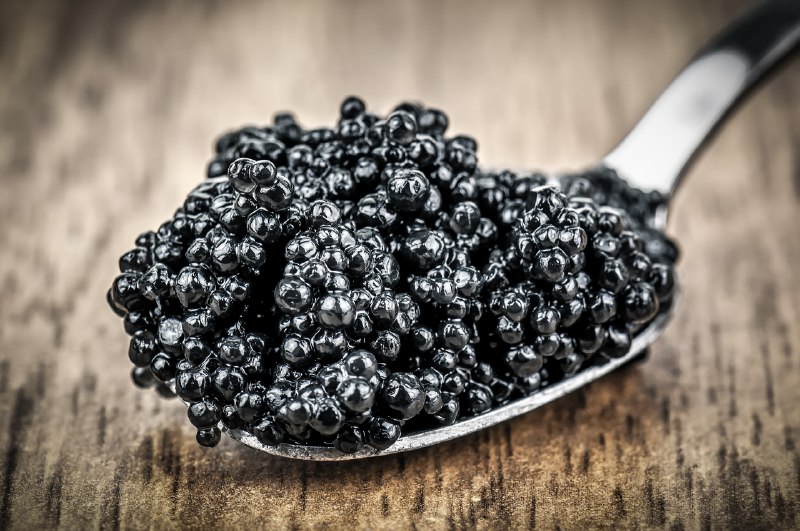What does black caviar taste like?

One of the greatest delicacies. This is what Alexandre Dumas, père, called black caviar, devoting special attention to it in his "Grand Culinary Dictionary." Modern Frenchmen, and others, regard caviar as nothing less than the queen of gastronomic delights. For many centuries, the taste of this product was considered known only to the elite and wealthiest. Its texture and light aroma thrilled even the most ardent gourmets. Even today, black caviar is a symbol of status and luxury. The main thing is that the product be natural. Let's try to describe the taste of real black caviar.
Marine accents and light nutty notes
According to the classic, slightly simplified description, black caviar harmoniously combines delicate saltiness and very characteristic marine notes. In fact, accents can vary significantly depending on the sturgeon species, the conditions under which they are raised, the method of caviar harvesting, and the freshness of the product. A gourmet can guess the fish from which the caviar originates by the taste of the caviar:
- Beluga – The bearer of the most valuable, delicate, and exquisite caviar with a soft, creamy flavor and subtle, pleasant nutty notes;
- Sturgeon offers a classic seafood flavor range with buttery and nutty undertones, maintaining a wonderful balance between richness and delicacy;
- Stellate sturgeon, with its smaller eggs, will delight those seeking a more vibrant, rich, and slightly tangy flavor.
- Sterlet has small, very dark eggs with a delicate, light flavor.
Thus, black caviar offers a palette of different flavors, from rich, marine to velvety-delicate. It should not be overly salty and cannot have harsh fishy accents – a pure, "oceanic" taste is paramount. If it's barely detectable, at best, one can suspect cheap preservation methods.
Traditionally, lightly salted caviar ("malosol") is prized, where the salt content is no more than 5%. This technique allows one to experience the true natural flavor of the eggs, unobscured by excess salt. Storage, temperature, and even the container material (glass, tin, or special mother-of-pearl spoons) also affect the flavor nuances: metal can impart an unwanted bitterness, so true connoisseurs never use ordinary spoons.
Texture as a special accent
The shell of truly fresh black caviar bursts pleasantly and easily on the tongue, releasing delicate juice. This should leave a feeling of freshness and create a small explosion, followed by a soft wave of flavor. If production or storage technology is not followed, the texture is affected, and the impression is spoiled.
The texture and taste of caviar also largely depend on the age of the fish. The older the fish, the larger and better the quality of the eggs. In mature fish, the caviar acquires a denser shell, a more pronounced "nutty" flavor, and a lingering aftertaste prized by gourmets.
At the same time, excessively aging sturgeon can negatively affect the taste: the caviar becomes too tough or has a sharp bitterness. Therefore, professionals always seek a balance, choosing fish that are mature enough but have not yet lost their optimal flavor characteristics.
So, is black caviar truly so unique that it's worth paying so much for, or is this just myth, tradition, and a tribute to high culture? This product is not one that becomes an instant favorite. A delicacy must be truly savored for its exquisite flavor to be revealed in all its complexity. It's like listening to a tender, quiet declaration of love after loud, flamboyant, yet casual compliments. At first, everything seems too vague, but only then are the subtlest nuances revealed.
Уважаемый клиент!
В связи с новогодними праздниками с 30.12.2019 года по 08.01.2020 года включительно, заказы не принимаются.
При заказе товара сегодня, его оформление будет осуществлено 09.01.2020 года!
Всех поздравляем с Новым Годом 2020 и Рождеством Христовым! Желаем Вам осуществления всех заветных желаний, достатка, любви и благополучия !!!!!
Друзья всех поздравляем с праздниками, желаем мира, здоровья и довольства!
Заказы принимаем до 17 часов 30.12 с отправкой сегодня.
Остальные заказы будут отправлены с 03.01.23 максимально быстро.
All orders received after 5:00 PM on December 30, 2024 will be processed and shipped on January 3, 2025.
All orders received before 17:00 30.12.2020
All orders received after the specified period will be processed before 01/05/2022
You are being redirected
to the payment page








